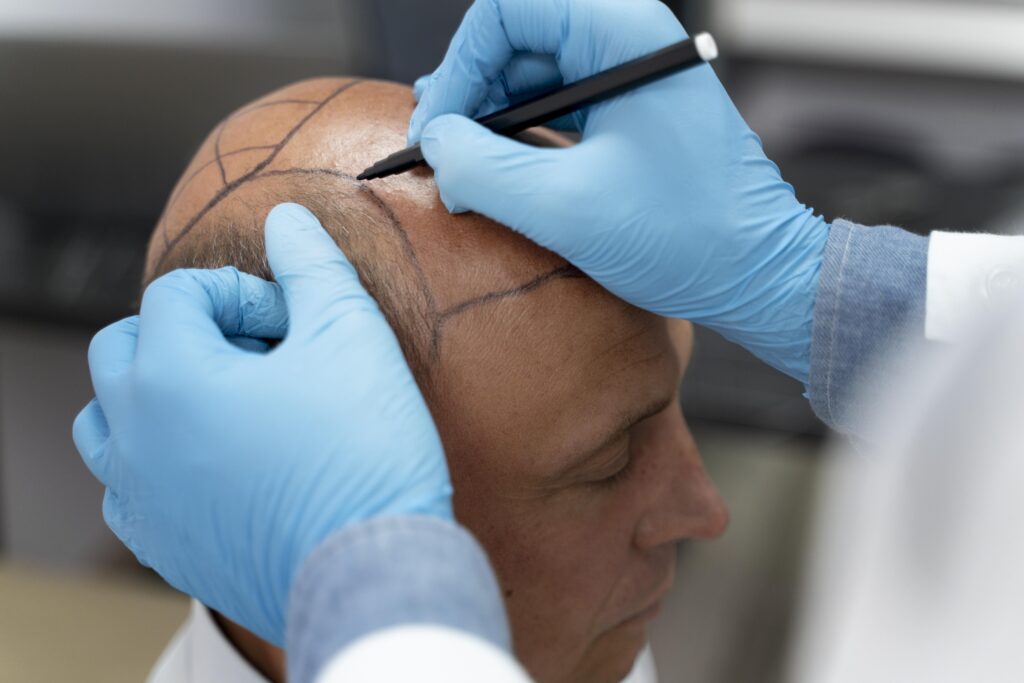Table of Contents
Table of Contents
Considering a career change into the booming aesthetics industry? You’re not alone. With the UK aesthetics market valued at over £3.6 billion in 2024 and growing at 8.4% annually according to the British Association of Aesthetic Practitioners, many professionals are looking for their entry point into this lucrative field. Scalp micropigmentation (SMP) has emerged as one of the fastest-growing specializations, with training courses across Britain seeing a 65% increase in enrolment since 2022.
But navigating the world of SMP training in the UK can be overwhelming. From finding legitimate certification programs to understanding the equipment requirements and business setup, the journey to becoming a successful SMP practitioner requires careful planning and insider knowledge.
In this comprehensive guide, we’ll walk you through everything you need to know about scalp micropigmentation courses in Britain, the certification requirements, and how to launch your career in this rewarding field. Whether you’re a barber looking to expand your services, an aesthetician seeking a new specialty, or someone considering a complete career change, this roadmap will help you make informed decisions about your SMP future.
What is Scalp Micropigmentation and Why Consider it as a Career?
Scalp micropigmentation is a specialized cosmetic technique that uses microneedles to deposit pigment into the scalp, creating thousands of tiny impressions that replicate the appearance of hair follicles. This non-surgical procedure has become increasingly popular for addressing hair loss, scar camouflage, and density enhancement.
As a career path, becoming an SMP practitioner offers several compelling advantages:
High Earning Potential
With the average SMP treatment in the UK ranging from £1,500 to £3,000, and typically requiring just 2-3 sessions to complete, qualified practitioners can generate substantial income. Many established SMP artists report annual earnings between £50,000 and £100,000, with top specialists earning significantly more.
“The return on investment for quality SMP certification can be exceptional,” explains James Wilson, founder of Elite SMP Academy in London. “Our graduates typically recoup their training costs within their first 5-10 clients.”
Low Overhead Costs
Compared to many other aesthetic procedures, SMP requires relatively modest equipment investment and can be performed in smaller spaces, making it accessible for practitioners starting their own businesses.
Flexible Working Options
Trained SMP artists can work independently, join established clinics, partner with barbershops or hair restoration specialists, or even offer mobile services – providing considerable lifestyle flexibility.
Rewarding Client Relationships
The transformative nature of SMP results in high client satisfaction and emotional rewards. “Nothing compares to seeing a client’s face when they first look in the mirror after their final session,” shares Emma Thompson, an SMP practitioner who transitioned from hairdressing three years ago. “The confidence transformation is immediate and profound.”
Essential UK Requirements for SMP Training and Certification
Before investing in scalp micropigmentation courses in the UK, it’s important to understand the regulatory landscape:
Insurance Requirements
Professional indemnity and treatment liability insurance are absolute necessities for practicing SMP in the UK. Most reputable insurance providers require proof of training from an accredited institution, typically requiring a minimum of 25-40 hours of hands-on training.
Health and Safety Certification
All SMP practitioners must complete a Level 2 Infection Prevention and Control qualification along with a Blood-Borne Pathogens certification. Additionally, you’ll need to register with your local council for a Special Treatments License or equivalent, depending on your location within the UK.
Industry Association Standards
While not legally mandated, membership in recognized bodies such as the UK Scalp Micropigmentation Association or the British Association of Hair Restoration Surgeons can provide credibility and access to continued professional development.
Comparing SMP Training Options in the UK
The best SMP training courses will provide comprehensive education covering theory, practical skills, and business development. Here’s what to look for:
Academy-Based Training
Traditional in-person courses at established academies remain the gold standard for comprehensive SMP education. These typically range from 3-5 days for basic certification to 7-10 days for advanced techniques.
Advantages:
- Direct hands-on experience with real models
- Immediate feedback from instructors
- Networking opportunities with peers and industry professionals
- Access to equipment for practice before purchasing your own
Cost Range: £2,500-£5,000 for comprehensive certification programs
Hybrid Training
Many UK academies now offer a blend of online theory modules followed by in-person practical training days.
Advantages:
- More flexible scheduling for theory components
- Can reduce overall costs and time away from current employment
- Often includes extended access to online resources and community
Cost Range: £1,800-£3,500 depending on the practical component duration
Online-Only Courses
While less common for complete beginners, online courses can be suitable for those with prior experience in similar techniques (such as microblading or permanent makeup).
Advantages:
- Lowest cost option
- Complete flexibility for working professionals
- Can be good for theoretical foundation before practical training
Cost Range: £800-£1,500 for comprehensive programs
“No matter which training path you choose, ensure the course includes practice on real models, not just silicone scalps,” advises Dr. Sarah Jenkins, trichologist and SMP training consultant. “The skin’s resistance, client positioning, and managing client comfort are critical skills that cannot be learned on synthetic surfaces alone.”
What to Look for in Quality SMP Training
When researching scalp micropigmentation courses in the UK, evaluate potential programs based on these criteria:
Curriculum Comprehensiveness
Quality training should cover:
- SMP fundamentals and theoretical foundation
- Different types of hair loss and assessment techniques
- Color theory and pigment selection
- Hairline design principles for different ages and ethnicities
- Needle configurations and machine settings
- Practice on multiple skin types and hair loss patterns
- Aftercare protocols and managing client expectations
- Business setup and marketing essentials
Instructor Credentials
Research the background of lead trainers, looking for:
- Minimum 3-5 years of professional SMP experience
- Strong portfolio of before/after results
- Teaching experience and positive student testimonials
- Recognition within the industry
Class Size and Support
Look for courses with:
- Small class sizes (ideally 4-6 students maximum)
- High instructor-to-student ratio
- Post-training support and mentorship options
- Online communities or forums for graduates
Equipment and Products
Quality programs should provide:
- Hands-on experience with professional-grade SMP equipment
- Information about different machine types and their applications
- Guidance on pigment selection and mixing
- Take-home materials and resources
Business Development Content
Comprehensive training should also include:
- Pricing strategies and business models
- Client consultation practices
- Portfolio building techniques
- Marketing and social media guidance
- Legal and insurance requirements
Essential Equipment and Startup Costs
After completing your SMP certification, you’ll need to invest in professional equipment. Here’s what to budget for:
Core Equipment
- SMP Machine: £800-£2,000 for professional quality
- Power Supply: £150-£300
- Needles: £100-£200 initial stock (various configurations)
- Pigments: £300-£500 for a starter range of colors
- Practice Skins: £100-£150
Treatment Room Setup
- Adjustable Treatment Chair: £400-£800
- Practitioner Stool: £100-£200
- Lighting: £200-£400 for professional lighting
- Magnification Lamp: £150-£300
Consumables
- Gloves, Barriers, Disinfectants: £200 initial stock
- Aftercare Products: £150-£250
- Client Forms and Documentation: £50-£100
Business Essentials
- Insurance: £300-£500 annually
- Website Development: £500-£2,000 depending on complexity
- Marketing Materials: £300-£500 initial investment
- Local Authority Licensing: £200-£400 depending on location
Total estimated startup costs after training: £4,000-£8,000
Building Your SMP Portfolio After Training
The period immediately following your SMP training course is crucial for building a portfolio that will attract paying clients.
Model Sessions
Most new practitioners offer 5-10 heavily discounted or free sessions to build their portfolio. These should be:
- Carefully selected to showcase different hair loss patterns
- Professionally photographed with consistent lighting and angles
- Well-documented with detailed before and after images
- Spread across multiple sessions to demonstrate the complete process
Documentation Best Practices
For each portfolio case, document:
- Multiple angles (front, sides, top, back)
- Close-up details of hairline and blending
- Natural lighting and studio lighting examples
- Healed results (4 weeks post-final session)
- Brief client testimonials when possible
“Your initial portfolio will be your most powerful marketing tool,” explains Thomas Reynolds, who transitioned from barbering to become a full-time SMP artist in Manchester. “I invested in professional photography for my first five clients, and those images secured me bookings for the next six months.”

Marketing Your SMP Services
After completing your scalp micropigmentation training UK program, implementing effective marketing strategies will be crucial for building your client base:
Digital Presence
- Create a professional website showcasing your certification, portfolio, and SMP process
- Establish business profiles on Instagram and Facebook, where visual content performs exceptionally well for aesthetic services
- Consider creating educational content on YouTube to establish authority
Local Networking
- Connect with barbers, hair salons, and hair transplant clinics for referral partnerships
- Offer educational sessions at men’s grooming events or wellness expos
- Join local business groups and chambers of commerce
Client Testimonials and Referrals
- Implement a systematic approach to collecting reviews and testimonials
- Create a referral incentive program for existing clients
- Document transformation stories (with permission) for marketing content
Continuing Education and Career Development
The most successful SMP practitioners commit to ongoing education well beyond their initial SMP certification UK training:
Advanced Techniques
Consider specialized training in:
- Advanced hairline design for different ethnicities
- Scar camouflage techniques
- Long-hair SMP for women
- Color correction and SMP repair
Business Growth Pathways
As your practice develops, explore:
- Opening your own dedicated SMP studio
- Training and employing additional practitioners
- Developing your own training program
- Creating SMP-related products or systems
Frequently Asked Questions About SMP Training
How long does it take to become qualified in SMP?
The basic certification can be completed in 3-5 days of intensive training, but most practitioners recommend a minimum of 3-6 months of regular practice before offering commercial services. Developing true expertise typically takes 1-2 years of consistent client work.
Do I need prior experience in the aesthetics industry?
While helpful, prior experience is not essential. Many successful SMP practitioners come from completely unrelated fields. However, having some background in art, aesthetics, or medical care can accelerate your learning curve.
What is the average income for UK SMP practitioners?
Entry-level practitioners typically earn £25,000-£35,000 in their first year, with established artists earning £50,000-£80,000. Top practitioners with strong marketing and premium positioning can earn well over £100,000 annually.
Can I practice SMP part-time?
Absolutely. Many practitioners start part-time while maintaining their existing career, gradually transitioning as their client base grows. This approach allows for lower financial risk during the portfolio-building phase.
Taking the Next Step Towards Your SMP Career
If you’re serious about becoming an SMP practitioner in the UK, begin by:
- Researching and requesting information packs from at least 3-5 reputable training academies
- Attending virtual open days or in-person introductory sessions
- Connecting with training graduates on social media to gain insights into their experiences
- Planning your financial investment strategy for both training and equipment
The demand for skilled SMP artists in the UK continues to grow as awareness of this life-changing treatment expands. With the right training, equipment, and business approach, you can build a rewarding, flexible, and financially substantial career helping clients regain their confidence through the art and science of scalp micropigmentation.

